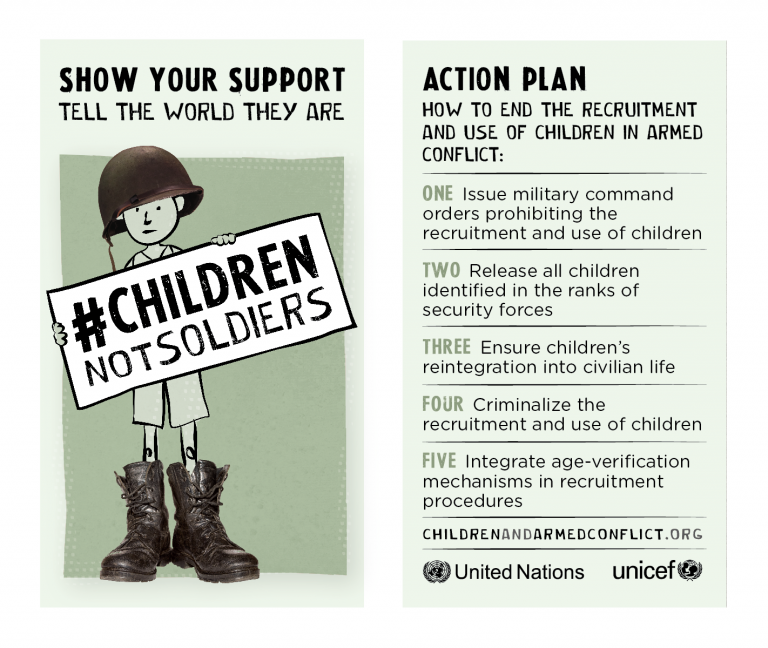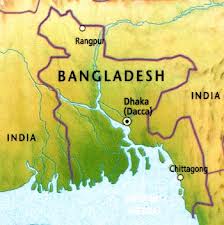 by Amy Hook
by Amy Hook
Most of us are accustomed to news bulletins exposing countries torn apart by civil war and instability. However, it is important to consider the children who are caught up in this net of hostility. The childhoods where education is neglected, playtime is fictional and lives are tainted. Many children are converted in this harrowing world, into child soldiers.
The news that armed groups in South Sudan were releasing more than 200 child soldiers in April was gratifying. Since violence arose between government and opposition rebel forces in 2013, as many as 19,000 children have been forcibly recruited as soldiers, according to a report by UNICEF.
See Also: Causes of Conflict in South Sudan: Oil and Weak Institutions
The geographical range in the use of child soldiers is vast. South Sudan is one of many countries around the world where children are recruited and used in conflicts by both state and non-state armed groups. Afghanistan, Democratic Republic of Congo, Iraq, Myanmar, Somalia and Yemen are all culpable in this respect.
A common stereotype of a child soldier is a youth carrying an AK47 over their shoulder. But, the role of a child soldier is not necessarily restricted to fighting. The role of both boys and girls can be as fighters, cooks, messengers, or as targets of sexual exploitation.
A common stereotype of a child soldier is a youth carrying an AK47 over their shoulder. But, the role of a child soldier is not necessarily restricted to fighting. The role of both boys and girls can be as fighters, cooks, messengers, or as targets of sexual exploitation. For instance, West African Islamic State terror group Boko Haram has increased its use of children as ‘human bombs,’ according to UNICEF. Irrespective of the responsibility of each child in their role, they are all exposed to the most intense levels of violence.
How Children Become Child Soldiers?
Circumstances of how a child becomes a soldier differ. Many children are forcibly abducted and taken as child soldiers, but many join armed groups voluntarily as they see few alternatives to participation in conflict around them. Influences are broad: joining as a means to survive, leaving a home life desperate with poverty and some are fuelled by retribution after seeing family members murdered.
Armed groups use gender as a malicious device. According to a report by Child Soldiers International, girls in armed groups in the Democratic Republic of Congo had experienced significant horrific sexual abuse and violence. But, when the girls returned home, many were ostracised by their communities and families and labelled as prostitutes. Thankfully, indispensible work from Child Soldiers International to improve community attitudes towards former girl child soldiers is helping to change their sentiment.
What has been done about child soldiers?
A number of organisations are working to stop the use of child soldiers. In 2014, the special representative of the secretary-general for children and armed conflict at UNICEF launched a campaign named ‘Children, Not Soldiers.’ The purpose was to bring a global understanding of the basic concept that child soldiers should not be used in conflict.

Since the ‘Children, Not Soldiers’ campaign started, numerous states have committed to having no child recruitment in their armed forces, and six have signed action plans to this effect. According to the UN, more than 5,000 children were released and reintegrated in 2017 as a direct result of this global commitment. It is definitely a step in the right direction and there seems to be a determination to tackle this issue with the on-going signing of official treaties and protocols. However, in countries where institutions and structures are damaged by conflict, implementational challenges remain a big barrier to agreement between the parties.
Child soldiers need more support
When estimates reveal that 300,000 children are enlisted as soldiers around the world, and with discussions between human rights groups and the UN confirming the issue is getting worse and shows no sign of abating, it is unquestionable that more could be achieved.
See Also: What do children play in the Colombian conflict?
As much as organisations continue to encourage the international community to commit much needed funding and resources to prevent the use of child soldiers and to support those children when they eventually return home, words of encouragement are simply not enough.
Today, the recruitment of children as child soldiers continues and the destructive practices persist, with the vulnerability of children being exploited. New strategies and active work around the world has to continue and advance at a much faster pace, if there is to be any chance of stopping the abuse of these children.
We can all help by taking part in fundraising and spreading the word about organisations that support children and work to halt the recruitment of child soldiers, allowing them to prolong their work. One example is of the charity War Child, which helps to rehabilitate ex-child soldiers in the Central African Republic and reintegrates them back into education.
The mental and physical scars of child soldiers make recovery difficult as they look to be reintegrated back into society. As the children develop into adults, their troubles and traumatic past can hinder their progress and communication with the outside world.
Each child has the right to a childhood, no matter where they are in the world.
It is difficult to envisage children fighting a war at such a young age, except perhaps when using their plastic figurines. Children forced in war and conflict should get the opportunity to understand there is a world outside conflict, where they can live in safety. Each child has the right to a childhood, no matter where they are in the world. With effort and action, the world must work to ensure child soldiers become a thing of the past. Children are not weapons of war, they are children and deserve a normal, happy childhood.
(Amy Hook is a freelance writer and final year Journalism and Creative Writing student at Falmouth University in Cornwall, UK. Her writing focuses on conflict and international development. In the future, she hopes to work with organisations who support and aid children in conflict zones.)










